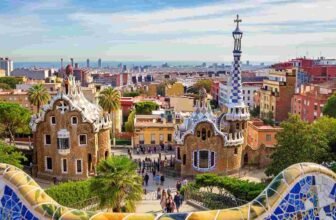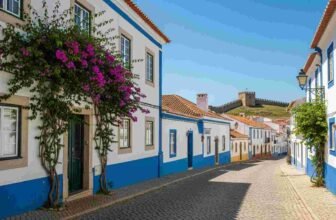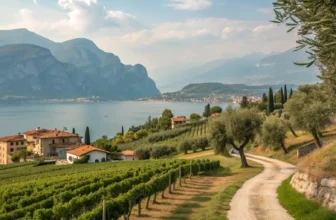
Crackling wood smoke rises into crisp mountain air, catching golden light as it spills across silent streets and candy-colored cottages. Morning feels slower here—intentional, untouched—like a forgotten scene from a dream you once had.
We crave more than just destinations now. We seek wonder. Discovery. Places that breathe with character and tell stories through their architecture, landscapes, and quiet corners.In a world oversaturated with tourist traps, these small towns offer something rare: authenticity wrapped in beauty. Each is a fairytale waiting to be walked into.
Ahead, you’ll find photo-perfect escapes—and the magic that lingers long after.
1. Sedona, Arizona

Nestled between rust-red cliffs and dotted with juniper trees, Sedona feels more like a painted dream than a real town. As the sun sets over the dramatic rock formations, the entire landscape glows with otherworldly light—perfect for photographers and spiritual seekers alike. From the moment you enter the winding roads flanked by towering formations like Cathedral Rock and Bell Rock, there’s an almost magnetic pull to stop and take it all in.
I remember climbing the twisted trail up to Devil’s Bridge just before golden hour. The silence was profound, broken only by the rustle of desert wind. Perched on that natural arch, with panoramic views of the red rock wilderness stretching out endlessly, I truly understood why Sedona is considered a vortex of energy. It’s not just scenic; it feels enchanted.
Key Practical Information
- Peak/Off-peak seasons: Spring (March–May) and Fall (September–November) offer the best weather and colors. Summers can be brutally hot, while winters are quieter but chilly.
- Getting there: Fly into Phoenix Sky Harbor Airport and drive 2 hours north. A car is essential to fully explore.
- Ideal visit: 3–4 days.
- Must-try experiences: Jeep tours through the red rock trails, vortex meditation sessions, hiking Cathedral Rock, and sunset at Airport Mesa.
- Budget: Mid-to-high. Boutique lodging and activities can be pricey, but hikes and views are free.
- Etiquette: Respect sacred Native American sites and the quiet solitude of vortex zones.
- Photo tips: Sunrise at Red Rock Crossing, midday at Chapel of the Holy Cross, and sunset at Doe Mountain offer unforgettable light and angles.
2. Carmel-by-the-Sea, California

Walking through Carmel-by-the-Sea feels like stepping into a whimsical European village. Storybook cottages with hand-carved doors and flower-filled gardens line cobblestone streets that lead straight to the ocean. There are no street addresses—just names—and cell service is spotty. It’s all part of the charm. Everything here seems curated for romance and wonder.
During a foggy morning stroll along Scenic Road, I watched waves crash below the cliffs while deer grazed beside ivy-covered homes. Later that day, I ducked into a hidden courtyard and discovered a gallery where the artist was painting live. That spontaneity, that blend of nature and artistry, is what makes Carmel unforgettable.
Key Practical Information
- Peak/Off-peak seasons: Fall (September–October) offers the clearest skies and smallest crowds. Summer is cooler than expected due to coastal fog.
- Getting there: Fly into San Jose or Monterey. It’s a 2-hour coastal drive from San Francisco.
- Ideal visit: 2–3 days.
- Must-try experiences: Browse local art galleries, walk Carmel Beach at sunset, dine at La Bicyclette, and drive the iconic 17-Mile Drive.
- Budget: High. Lodging, dining, and shopping are upscale.
- Etiquette: No chain restaurants, no neon signs, and dogs are welcome everywhere (even some wine tastings!).
- Photo tips: Capture the fairytale cottages early morning, Point Lobos for dramatic seascapes, and the Lone Cypress for iconic coastal shots.
3. Bar Harbor, Maine

Tucked along the edge of Acadia National Park, Bar Harbor combines rugged Atlantic beauty with timeless New England charm. Think sailboats bobbing in the harbor, fresh lobster shacks, and misty mountains rising just beyond the shoreline. The streets are alive with energy—tourists in hiking boots, artists painting outdoors, and salty sea air wafting through every scene.
One of my favorite moments here was watching the sunrise from the top of Cadillac Mountain, the first place in the U.S. to catch the morning sun. I was wrapped in a blanket, sipping coffee from a thermos, as gold poured over the forest and sea below. It was cold, quiet, and absolutely magical.
Key Practical Information
- Peak/Off-peak seasons: Fall (September–October) is spectacular for foliage. Summer is bustling but beautiful. Winters are harsh and most businesses close.
- Getting there: Bangor International Airport is the closest, about 1.5 hours away. Renting a car is essential.
- Ideal visit: 3–5 days.
- Must-try experiences: Explore Acadia’s Carriage Roads by bike, eat a lobster roll at Beal’s Lobster Pier, and go tidepooling on Sand Beach.
- Budget: Moderate to high, especially in summer.
- Etiquette: Be mindful of local conservation efforts—pack out trash and stay on trails.
- Photo tips: Capture low tide at Bar Island, fall colors in Jordan Pond, and starry skies from Sand Beach after dark.
4. Telluride, Colorado

Set in a box canyon surrounded by the dramatic San Juan Mountains, Telluride looks like it was carved out of a wild dream. Once a mining town, now a haven for creatives and adventurers, its blend of Victorian buildings, cascading waterfalls, and alpine wilderness makes it jaw-dropping in every direction.
I arrived in summer during the Telluride Bluegrass Festival. Sitting on the grass in Town Park with a cold beer, I watched as paragliders floated down from the peaks while banjos strummed in the distance. Later that day, I took the free gondola up to Mountain Village, where the sunset lit the cliffs in a fiery orange haze. It felt like the edge of the world—and I never wanted to leave.
Key Practical Information
- Peak/Off-peak seasons: Summer (June–August) and winter (December–March) are peak. Fall is breathtaking and quieter.
- Getting there: Fly into Montrose (90 minutes) or Telluride Regional Airport. Free gondola connects Telluride and Mountain Village.
- Ideal visit: 3–4 days.
- Must-try experiences: Hike to Bridal Veil Falls, ski the back bowls, attend a summer music or film festival.
- Budget: High. Lodging and dining reflect its luxury-ski-town status.
- Etiquette: Locals are outdoorsy and laid-back; respect trail etiquette and pack layers.
- Photo tips: Fall foliage along Last Dollar Road, panoramic views from the gondola, and snow-covered Main Street in winter.
5. Leavenworth, Washington

Straight out of Bavaria with a dash of Pacific Northwest magic, Leavenworth is a surprise tucked into the Cascade Mountains. Every storefront, sign, and structure is built in traditional Alpine style—think flower boxes, gingerbread trim, and murals of mountain goats. The backdrop? Towering peaks and pine forests that change color dramatically with the seasons.
One winter, I visited during the Christmas Lighting Festival. Snowflakes danced in the glow of thousands of twinkling lights while carolers sang in the square. The smell of bratwurst and mulled wine filled the air. It didn’t feel like America—it felt like a snow globe brought to life.
Key Practical Information
- Peak/Off-peak seasons: Winter (December) for festive magic; Fall for stunning foliage; Summer is popular for river tubing and hiking.
- Getting there: Fly into Seattle and drive 2.5 hours over scenic mountain passes.
- Ideal visit: 2–3 days.
- Must-try experiences: Attend Oktoberfest, visit the Nutcracker Museum, try schnitzel at Andreas Keller, and float the Icicle River.
- Budget: Moderate, though festivals can raise prices.
- Etiquette: Embrace the town’s kitschy charm. Many residents participate in the Bavarian theme, so join in with cheer.
- Photo tips: Capture festive lights in winter, golden larches in fall hikes, and colorful shop fronts any time of year.
6. Woodstock, Vermont

There’s something quietly magical about Woodstock. It’s the kind of place where autumn paints the town in fire—burnt orange, russet red, golden yellow—and every step crunches under fallen leaves. White steepled churches, covered bridges, and heritage farms create a sense of timelessness. You don’t just see Woodstock—you feel it, especially as you stand beneath the canopy of maple trees on Elm Street, watching locals sip cider outside rustic cafés.
I remember wandering the grounds of Billings Farm & Museum, where cows grazed lazily and families picnicked on the grass. The moment that truly captured me, though, was catching the sunrise over the Ottauquechee River, where fog lifted like a curtain to reveal the sleepy beauty of the town waking up. It’s a photographer’s dream—quiet, authentic, and unexpectedly profound.
Key Practical Information
- Peak/Off-peak: Fall (September–October) is iconic for foliage; winter brings charm with snow-covered lanes. Spring is quieter but offers blooming wildflowers.
- Getting there: Best reached via car from Burlington or Boston. Walking and biking are ideal for exploring.
- Ideal duration: 2–3 days for full immersion.
- Must-try experiences: Maple creemee, local farmers market, Marsh-Billings-Rockefeller National Historical Park.
- Budget: Moderate—mid-range B&Bs and local eateries dominate.
- Cultural tips: Vermonters value sustainability—respect nature and shop local.
- Photo ops: Middle Bridge, The Green, farm vistas, and panoramic autumn hills.
7. Beaufort, South Carolina

Beaufort feels like it was dipped in honey and aged slowly under moss-draped oaks. It’s all Southern charm and Spanish moss, where antebellum mansions stand proudly along the waterfront and history whispers through every brick. There’s a stillness here that invites reflection—and perfect Instagram captures in golden hour light.
One early morning, I found myself walking the Henry C. Chambers Waterfront Park, camera in hand, when I turned to see the sunrise spill orange and pink across the harbor. A local fisherman waved from a small skiff—“You caught it on a good day,” he said. Truth is, every day here is a good day for your lens and your soul.
Key Practical Information
- Peak/Off-peak: Spring and fall offer mild, breezy weather; summers are hot and humid but picturesque.
- Getting there: Drive from Savannah or Charleston; walk the historic district on foot.
- Ideal duration: 2 days, especially for a romantic escape or quiet solo trip.
- Must-try experiences: Gullah culture tour, Lowcountry seafood (shrimp and grits!), kayak in the estuaries.
- Budget: Affordable; boutique inns and cozy guesthouses abound.
- Cultural tips: Respect African-American heritage sites, and support local artisans.
- Photo ops: Live oak-lined streets, The Anchorage 1770, waterfront sunrise.
8. Taos, New Mexico

Taos doesn’t shout for attention—it whispers. And somehow, that whisper gets under your skin. Ringed by the Sangre de Cristo Mountains and steeped in centuries of Native, Hispanic, and Anglo culture, this high-desert town feels like an echo from another time. Adobe walls, wide skies, and a creative energy that buzzes beneath the surface make Taos feel both grounded and otherworldly.
One quiet morning, I stood at the edge of the Rio Grande Gorge Bridge, wind whipping across the steel span, the canyon yawning beneath me. No camera could do it justice. That’s the kind of beauty Taos offers—not flashy, but unforgettable. You leave with red dirt on your boots and something harder to name in your chest.
Key Practical Information
- Peak/Off-peak: Best in fall (September–October) for golden aspens and crisp hikes; winter draws skiers, summer brings art lovers.
- Getting there: Closest major airport is Albuquerque (2.5-hour drive). Santa Fe is 1.5 hours away. Car recommended.
- Ideal duration: 3–4 days to explore the town, art scene, and surrounding nature.
- Must-try experiences: Taos Pueblo tour (a UNESCO site), Rio Grande Gorge, Earthship Biotecture, Taos Plaza, local galleries.
- Budget: Moderate; lodging ranges from rustic to boutique chic. Winter ski season raises prices.
- Cultural tips: Ask before photographing locals, especially at Taos Pueblo. Respect local customs and sacred spaces.
- Photo ops: San Francisco de Asís Church, sunset over the Gorge, Taos Pueblo, snow-dusted peaks behind adobe buildings.
9. Marfa, Texas

Marfa isn’t just a town—it’s a vibe. A surreal blend of desert minimalism and avant-garde art, it’s where tumbleweeds roll past art installations and minimalist design meets West Texas grit. You arrive expecting to photograph quirky buildings—and leave having captured something metaphysical.
I’ll never forget the moment I stood before Prada Marfa, the faux storefront glowing under a violet sunset sky, the silence around me broken only by desert wind. Then, driving back, the Marfa Lights flickered in the distance—ghostly, unexplained, and mesmerizing. It’s a place that feels both ancient and futuristic, with a touch of the otherworldly.
Key Practical Information
- Peak/Off-peak: Fall and spring are best for weather; summer is scorching but less crowded.
- Getting there: Fly to El Paso or Midland, then drive 3+ hours; a car is essential.
- Ideal duration: 2–3 days for art, sky, and soul searching.
- Must-try experiences: Chinati Foundation tour, stargazing at McDonald Observatory, local food trucks.
- Budget: Surprisingly varied—from hipster luxe to desert modest.
- Cultural tips: Engage with local art respectfully—many installations are private or guided only.
- Photo ops: Prada Marfa, art spaces, minimalist architecture, high desert sunsets.
10. Galena, Illinois

Galena is like a scene lifted from a Victorian-era novel—brick-lined Main Street, stately 19th-century mansions, and gas lamps that flicker romantically at dusk. It’s steeped in history but feels warmly alive, with cozy shops, artisanal bites, and stunning hillside views of the Mississippi River.
During my visit, I was enchanted by Ulysses S. Grant’s home, perched like a sentinel over the town. Later, I sipped wine at a local vineyard while hot air balloons drifted overhead—a scene so idyllic I nearly forgot it was real. Galena is Midwest charm distilled into cobblestones and candlelight.
Key Practical Information
- Peak/Off-peak: Fall is brilliant for colors; winter offers holiday magic with festive lights.
- Getting there: Drive from Chicago (3 hours); walking and trolley tours are great ways to explore.
- Ideal duration: 2 days, especially for a weekend getaway.
- Must-try experiences: Wine tasting, Grant Home State Historic Site, P.T. Murphy Magic Theatre.
- Budget: Mid-range to premium; lovely historic inns available.
- Cultural tips: Locals are proud of their heritage—ask questions, be curious.
- Photo ops: Downtown facades, river overlooks, Vinegar Hill limestone buildings.
11. Saugatuck, Michigan

Saugatuck is where lakefront leisure meets boho creativity. A former artist colony, this small town is framed by dune-covered beaches and a thriving arts scene, with gallery-lined streets and waterfront patios perfect for golden hour sipping. It’s beachy but sophisticated—a laid-back place with a wild heart.
I spent one afternoon sketching near Oval Beach, the water sparkling as boats cut across Lake Michigan. Later, a gallery owner invited me in for a chat about local painters, offering a glass of Michigan rosé. It’s the kind of place where strangers become friends, and beauty is never more than a few steps away.
Key Practical Information
- Peak/Off-peak: Summer is high season for beach life; early fall is quieter, with rich foliage.
- Getting there: Drive from Chicago or Grand Rapids; town is walkable and bike-friendly.
- Ideal duration: 2–3 days for beach + culture balance.
- Must-try experiences: Dune rides, art gallery hopping, sunset at Mount Baldhead.
- Budget: Moderate; higher in summer.
- Cultural tips: Respect dune ecosystems—stay on marked trails.
- Photo ops: Oval Beach dunes, harborfront sunsets, colorful storefronts.





